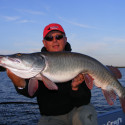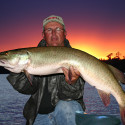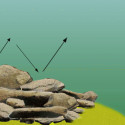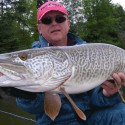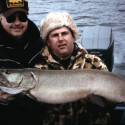By Joe Bucher
Fall is a season of constant change, and that alone suggests that anglers must also be open to “change” in order to stay on top of fish location as well as a productive fishing pattern. Consistency with fall muskies is rarely attainable unless up keep all options on the table. Even then, you are sure to run into some dead fishing on your favorite waters as they chill down. Brief warming trends in both October and November also throw a unique wrinkle and often shut activity down dramatically until another front arrives. In fact, most musky waters experience several lull periods throughout the fall. These dramatic drop-offs in fish activity are caused by the annual fall turnover as well as “Indian Summer” like weather.
The location of muskies throughout the fall varies greatly depending upon the water temperature, length of day, and the body of water being targeted. This is why it is a mistake to categorize or generalize all musky fishing in the fall as one single subject. The weather, water temperature and length of day in September are certainly far different from that in November. Yet, some anglers as well as outdoor writers continue to refer to “fall musky fishing” as one period, and mistakenly think you can fish for muskies the same way from Labor Day ‘til ice up. This simply isn’t true. What works in September rarely works in October, and certainly isn’t going to get it done in November.
Warming trends usually result in the best fishing throughout June, July and August. Yet this same weather is often a dud in the fall. Instead, the arrival of a cold front is far more productive for October and November muskies. A drop in barometric pressure along with a decrease in water temperature appears to be the key to a fall musky feeding binge. As the amount of daylight shortens more each day, muskies as well as all other fish and game seem to sense the approach of winter. Larger females, in particular, have now developed egg sacs and feel the need to feed heavily in order to nourish their young. This maternal urge is probably what makes them most susceptible at this time of year.
In general, muskies are apt to be shallower while water temperatures hold above the 50 degree range. Remaining stands of healthy weeds are one of the very best spots to start. The fact that most of the weeds have died-off already works to your advantage in pinpointing musky location. The odds of finding a trophy class fish in any weedbed steadily increase as the mass of weeds depletes. Whatever is left healthy and standing is likely to still attract and hold a fish. However, weeds become far less productive once the water temperature dips below 50.
Rocks as well as other hard bottom substrates become the most consistent producer as the calendar creeps towards November and water temperatures dip into the 40s. But not just any rocks will do. Usually, steeper breaks are also a key component. While summer as well as early fall fish are regularly found on large flats with tapering bottom contours, mid to late fall bruisers seem to like sharp drop-offs much more so. Hard bottom points with quick breaks into deep water are usually late fall musky hotspots. Add some submerged wood to this equation and it becomes even better.
Speaking of wood, submerged wood is yet another cover element that holds strong fall muskie potential, and is particularly good in October, but will continue to produce in November if it is situated in deeper water. One of my best fall patterns as a musky guide years ago centered on casting to both shoreline and submerged wood off steep breaking shorelines. This pattern produced hundreds of muskies for me and my clients for decades.
Lure choice in the fall depends a lot upon the time of year and the depth the fish are holding at. Bucktails can be good for October muskies, but one absolute key in the presentation —— S L O W. For some odd reason, a muskie will chase down a fast moving crankbait or an erratic action jerkbait during the colder water periods, but has almost no interest in a spinner that moves fast. Bucktails can indeed take some big fall muskies, if the fish continue to hold shallow, but you have to work them very slowly. As soon as the fish move deeper, spinners of any kind seem to lose their appeal.
Jerkbaits have a legendary reputation as fall musky producers, but I think the sinking or suspending style glider bait is better as the water gets colder. There are many excellent models to choose from. Find one that fits your style, and fish it hard over high percentage fall hotspots. They really produce when muskies are still in relatively shallow castable range.
Crankbaits are always good no matter what the season, but they come into their own during the month of October. I personally rely heavily on a crankbait for fall muskies since it can be worked in a wider range of effective retrieve speeds, and I can get it closer to deeper fish. One key difference between casting a crankbait for fall muskies versus the bucktail or jerkbait is in cover contact. While the bucktail and jerkbait are higher riding lures that tend to work best as you avoid cover, the crankbait triggers a higher percentage of fish each and every time it collides with something underwater.
If trolling is your game, crankbaits are sure to be your main weapon, but today’s trollers concentrate far more on off-bottom fish. Trollers are now tagging big fall muskies regularly over large featureless flats as well as deep open water. These are spots that are simply unreachable with traditional casting tactics. Yet trolling allows you to cover both featureless flats and deep open water very efficiently. Add modern GPS to the mix and you are able to reconnect with “needle in the haystack fish” fairly consistently.
Perhaps the best late fall casting lures to hit the market in decades are the vast array of sinking soft plastic swim baits. In many instances, these lures have revolutionized the game of casting for deep water muskies. Anglers all over the musky world are now fishing exclusively with this lure style in the colder water when fish move deeper and become bottom tight. These baits require a super heavy action rod and strong shoulders, but the results they provide suggest they are worth throwing.
Livebait fishing is yet one last technique worth mentioning since it is so widely used in the later fall in unique circles such as Wisconsin. Drifting, trolling or still fishing with live sucker minnows is a fall tradition in the Badger state that goes back nearly 100 years. The biggest difference today is the development of quick-strike style livebait rigs that allow the angler to set the hook soon after the strike instead of waiting for the musky to completely swallow the bait. No doubt, livebait is extremely effective on cold water muskies and I have certainly taken my share of big ones with this method when I was still guiding. It remains as effective today as it ever was.
Finally, weather and arctic-like elements become a factor any time you attempt to chase muskies during November. You have to both mentally and physically prepare yourself to fish during this final month. This is when a muskie angler is truly challenged on many fronts. Cold water musky fishing is a cold weather, deep water game. You have to dress appropriately, and fish accordingly. It’s a far cry from early September’s 60 degree weather and shallow feeding muskies on rock reefs. Instead, it is often grueling and a true test of your grit. Slow fishing and frigid weather is sure to challenge your psyche as well as your sanity. But one strike from a lunker is sure to make the pain fade quickly.
The fall is a superb time to tag a trophy for sure. Yet it’s also a time of change. You must be willing to try lots of different areas and a variety of presentations. You must be willing to brave the cold, as well. While some fall days are amongst the most beautiful of the year, it can also get “nasty”. Take along plenty of warm clothes including neoprene gloves. You can always take them off; but if you don’t have them —– you’re going to be miserable.
Being prepared ensures you’ll be on the water when the big ones bite. While I’ve caught a few memorable muskies on beautiful fall days, I’ve caught far more big ones during those ugly weather outings. The worst of weather seems to bring out the best in big fish action. Put your time in on a big fish lake, and stick with a productive technique that fits your style. The fall offers you the best overall chance to catch the fish of a lifetime.
